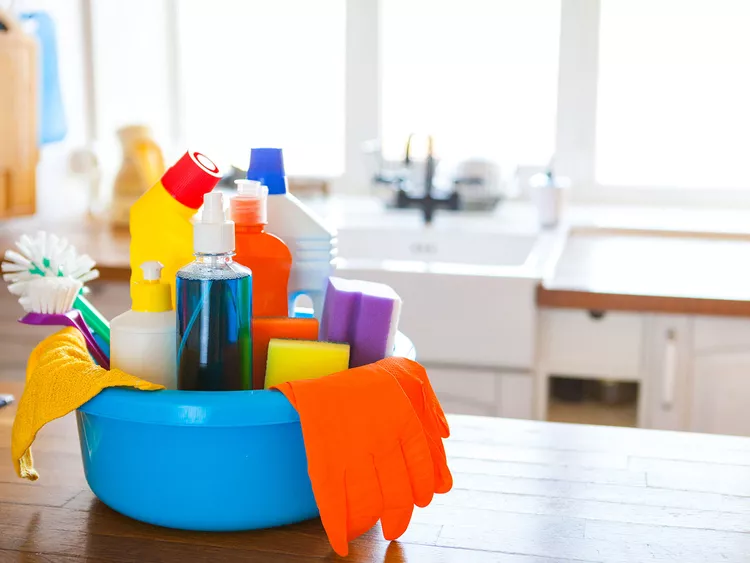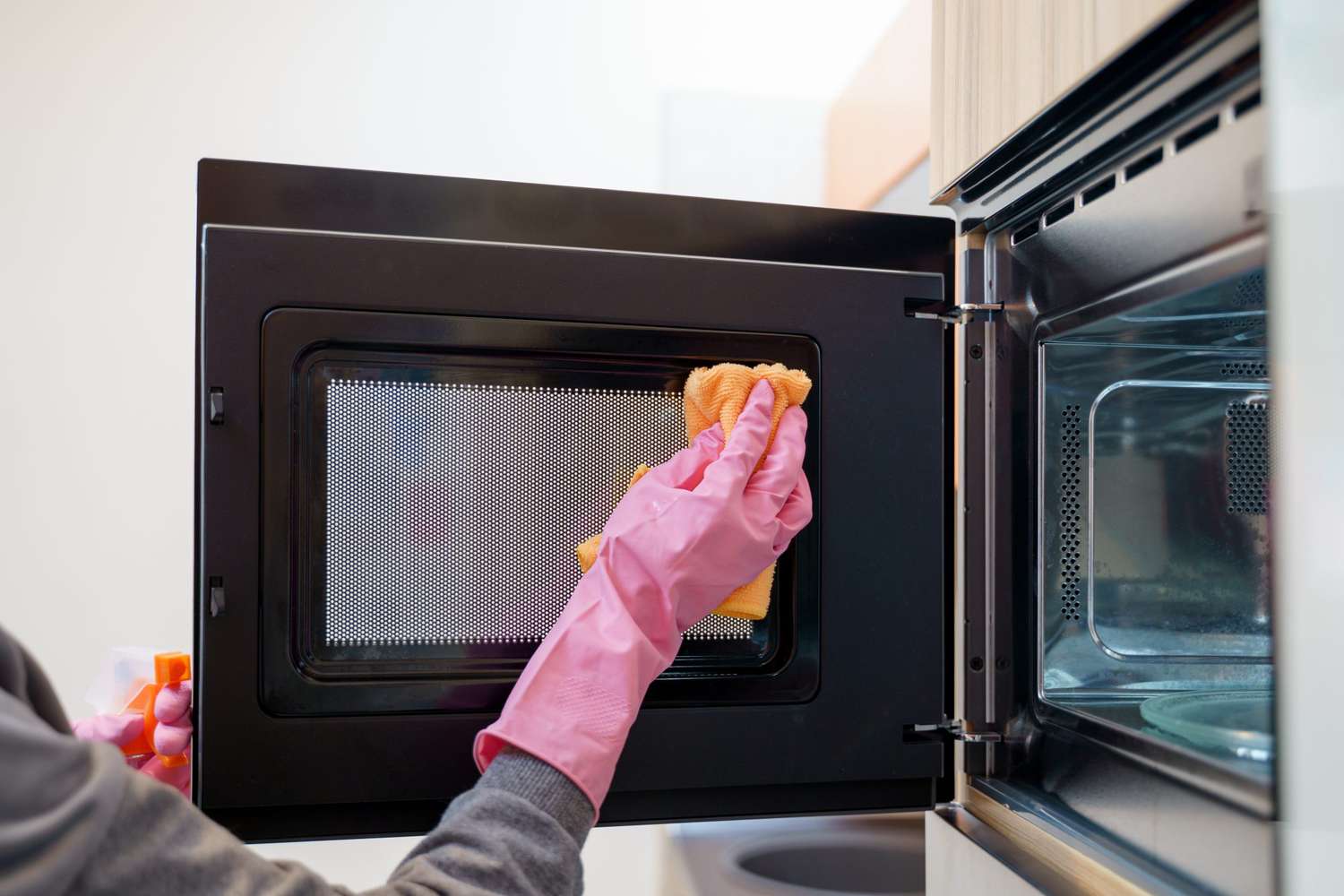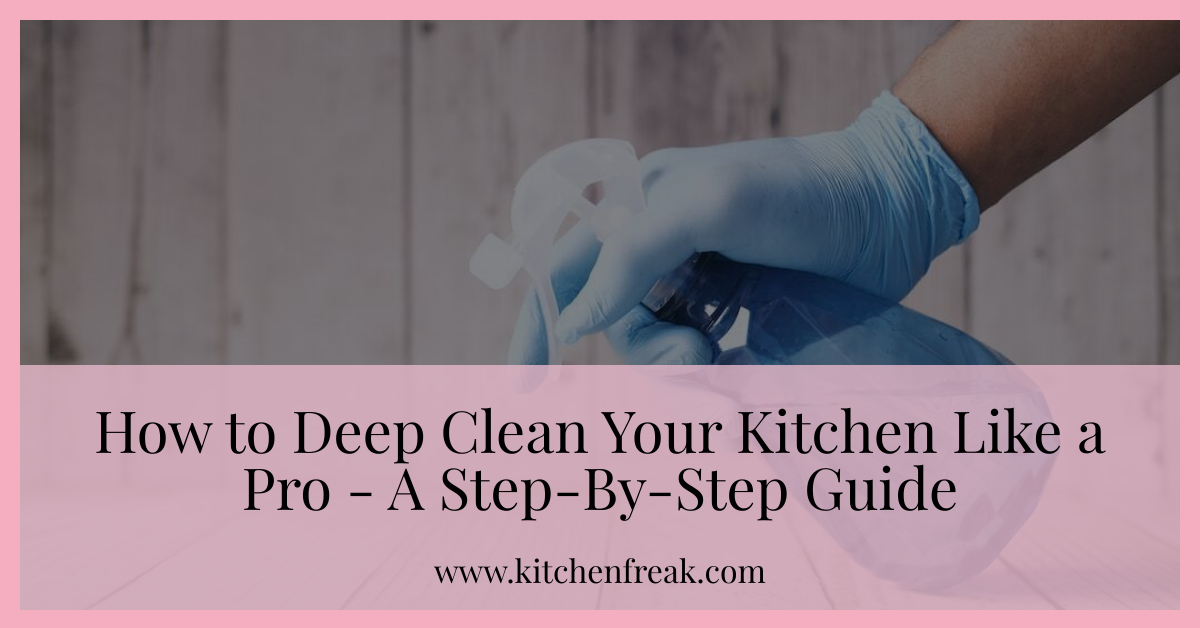Table of Contents
How to Deep Clean Your Kitchen
Ah, the kitchen! The heart of your home, where meals are prepared, bonds are created, memories made. And, flip side of the same coin, it’s where the maximum grime, grease, and clutter usually settle over time. But no worries! We are now going to guide you through the process of truly giving your kitchen the scrub it deserves. It’s not just about making your kitchen sparkle; it’s about creating a healthier, more enjoyable space for cooking and gathering. So, roll up your sleeves for the spring cleaning, and let’s get to the step-by-step kitchen cleaning checklist.
Supplies necessary kitchen deep cleaning
So before we hit the cleaning business, let’s grab our cleaning gears. We need:
– Multi-Purpose Cleaner and Degreaser
– Baking soda and white vinegar (your best eco-friendly assistant)
– Dish soap
– Microfiber cloths, scrub brushes
– Sponges and steel wool
– A toothbrush (for tricky corners)
– Rubber gloves to protect your hands
– A duster and vacuum cleaner with attachments
– Trash bags for decluttering

Fresh start and declutter
The first step in the clean-up—or, even better, deep clean—is getting rid of clutter. Go section by section, whether it be the countertop, the pantry, or your kitchen gadget drawer. Ask if each of these items is necessary, used regularly, or just an occupier of space. For gadgets and utensils, if you haven’t used it in the past year, it’s probably ripe for donation or disposal. This can almost be a cathartic process when considering that it doesn’t clear only physical space but also reduces mental clutter, therefore allowing the kitchen to become a more serene environment.
The grease triangle: stove, backsplash, and hood
Most of the mess in a kitchen typically lands around the stove, including the backsplash and hood, due to food splatter and grease. Take vinegar and water, mix equal parts, and it cleans about anything naturally. Then add a few drops of the essential oil of your choice and it smells great. This stuff can actually help to cut through the grease without all the chemicals most cleaners have. Next, soak the stove grates and burners in hot, soapy water to loosen the grime and make it easier to clean.
Refrigerator
In order to deep clean the refrigerator, take everything out and actually sort the items. This actually provides an awesome opportunity to inventory what you have, and to plan meals around these items to avoid waste, making your shopping list out of what you need. Consider lining each shelf and drawer with cling film or washable liners. This will help to make the next clean-up a lot easier. While you give each shelf and drawer a good scrub with soapy water, of course.
Clean your oven and microwave
For the more determinedly encrusted baked-on food in the oven, a paste made up from bicarbonate of soda and water smeared on and left overnight will work wonders. A little work with a pad in the morning will remove even the most doggedly burnt-on stuff. Just remember to clean the oven door glass with water and a little baking soda on a soft cloth to avoid scratches. When it comes to stainless steel exteriors, a microfiber cloth with a drop of olive oil is great for polishing and removing fingerprints naturally without any harsh chemicals.

Don’t forget to wipe the sink and countertops
Every day, sinks and countertops have to meet their challenge.
One has to make a decision about proper cleaning means in order to keep them neat and integral. For example, a pH neutral cleaner is required in the case of natural stone countertops to avoid etching. A paste of baking soda and water can eliminate the stain from laminate counters sans hampering the surface. Do not forget to unclog the drain and disposal in the case of sinks. To clean and keep drains odor-free, a mixture of baking soda and vinegar, followed by boiling water, can be used.

Deep clean kitchen cabinets and drawers
When throwing out old drawers and cabinets, add organizational items like shelf liners, spice racks, and utensil holders.
These tools can help keep your space tidy and make items more accessible. Additionally, consider how the stuff is organized in a frequency of use, where things used on a day-to-day basis are supposed to be readily available and things seldom used are to be shelved high or in less accessible cabinets.

Clean small appliances
It is because small appliances like toaster, blender, stand mixer, and coffee maker are usually crumb- and residue-prone, thereby causing performance issues. Empty the crumb trays at least once a day and keep the exteriors wiped down. It will even clean and descale a coffee pot by running a full cycle through with a 1:1 mixture of water and vinegar, followed by a few cycles of just plain water to flush out the insides so that morning coffee tastes the way it is supposed to.
Dishwasher
Your dishwasher is doing a good job of cleaning your dishes, but it also needs some regular cleaning of its own.
Cleaning a dishwasher is fairly a simple process. Apart from cleaning the filter and running a vinegar cycle, take a look at the spinning arms for clogs and use a toothpick or an old toothbrush to clean out any debris. This will guarantee that the water moves more freely and goes to enhance the effectiveness of your dishwasher and the power it possesses in cleaning.
Garbage can: A fresh start
Scrub and deodorize the nasty smell of your garbage can and think of the option of using some kind of liner or a bag that will control odors or at least neutralize them.
Others are scented or contain substances for absorption of odors, which might help in preventing the bad odors between cleanings. Regular emptying of the trash before overflow and instant wiping off of any spills can help stop the occurrence of bad odors.
Pantry deep clean
A deep clean of the pantry really means getting the most space, and as you clean and put things away, think about how it could be organized to really make it work for you.
For instance, to easily retrieve something, all baking ingredients, snacks, and canned goods are categorized together. Deep shelves can be organized with similar things in bins or baskets—then, everything can be pulled out to grab what you need without having to dig through the back. Dusting: things hiding in plain sight
When dusting, pay special attention to areas that are often overlooked, such as the tops of cabinets, refrigerator, and the space behind the stove.
These areas can collect a surprising amount of dust and grime over time. All of this can easily be attended to using a vacuum that has a brush attachment, and your kitchen will be dust-free and ready for use.
Wall decor and light fixtures
Clean light fixtures give a good look to the lights and also give better performance. Glass fixtures give a streak-free shine if wiped with water mixed with vinegar. For metal or painted fixtures, a damp cloth with a mild soap solution gets rid of dust and grime without causing damage.
Degrease kitchen walls
In the context of the kitchen walls, some common types of dirt can be grease and food stains, particularly if the walls are above the stove and the sink area. These can be removed in a solution of degreaser diluted or with a blend of dish soap and water applied with a soft sponge, which will not damage the paint. For the most challenging stains, make a thick paste of baking soda and water, scrub over the stain, and wipe up the paste with a damp cloth.

Mopping the floor
Floor cleaning is equally important to keep your kitchen tidy. Switch your water frequently to keep from distributing the dirt and grime around while mopping. To prevent your grout from getting damaged, it’s best to use a cleaner with a neutral pH in your tiled floors. For hardwood or laminate, it’s best to use a mild cleaner with a damp mop to avoid water damage.
Conclusion: Enjoy a Pristine Kitchen.
A lot of work comes with deep cleaning, but the results are satisfying. Your kitchen will not only look and feel clean but, most importantly, you will have a healthy environment to cook and dine in.
Regular maintenance will help it look good and reduce the need for those intensive cleanings that you’ve just finished. Enjoy your sparkling kitchen, and happy cooking! With this detailed guide, your kitchen will really look refreshed, and not just clean, but also inviting and usable.
The satisfaction derived from cleaning the kitchen through and through, whether this is done in a weekend or over a few days, is absolutely incomparable. After all, the kitchen is the heart of a happy home.
Kitchen Deep Cleaning Checklist – FAQs
Q: What does it mean to deep clean my kitchen?
A: Deep cleaning your kitchen means thoroughly cleaning all surfaces, appliances, and areas, including those that are often overlooked in regular cleaning routines. It involves cleaning nooks and crannies, removing clutter, and scrubbing away stubborn grime to achieve a sparkling clean and hygienic kitchen.
Q: How often do I need to deep clean my kitchen?
A: It is recommended to deep clean your kitchen at least once every few months, especially if you do a lot of cooking. However, you may need to do it more frequently depending on how heavily the kitchen is used and whether spills and messes are common.
Q: What are some tips for deep cleaning my kitchen?
A: Some tips for deep cleaning your kitchen include working from top to bottom, using an all-purpose cleaner, focusing on areas that are often overlooked, and running the dishwasher with cleaning supplies to keep it fresh and odor-free.
Q: Can you provide a step-by-step guide for deep cleaning my kitchen?
A: Certainly! A step-by-step guide for deep cleaning your kitchen involves decluttering, cleaning from top to bottom, focusing on appliances and surfaces, scrubbing away stuck-on grime, and wiping down the fronts of cabinets and appliances to achieve a sparkling clean kitchen.
Q: How do I clean my kitchen from top to bottom?
A: Cleaning your kitchen from top to bottom means starting with high surfaces such as cabinets and light fixtures, then working your way down to countertops, appliances, and finally the floor. This approach ensures that any dust or debris is effectively removed and doesn’t settle on areas that have already been cleaned.
Q: What is the best way to clean the inside of my refrigerator during a deep clean?
A: To clean the inside of your refrigerator during a deep clean, start by removing all items, checking for anything expired, then wiping down shelves and drawers with a solution of warm water and a small amount of dish soap. For tough stains or odors, you can use a mixture of water and distilled white vinegar.
Q: How can I clean my kitchen floor to achieve a sparkling clean result?
A: To achieve a sparkling clean kitchen floor, start by sweeping or vacuuming to remove loose debris, then mop with a solution of water and a specialized kitchen floor cleaner or a mixture of water and distilled white vinegar. Ensure the floor is thoroughly rinsed and dried for a sparkling finish.
Q: What should I focus on when deep cleaning my kitchen to achieve a deeper clean?
A: When deep cleaning your kitchen, focus on areas that are often overlooked in regular cleaning routines, such as the inside of appliances, nooks and crannies, the kitchen sink, and the exterior of cabinets. This will help you achieve a deeper clean and maintain a hygienic environment.
Q: How should I tackle cleaning the nooks and crannies in my kitchen?
A: Cleaning the nooks and crannies in your kitchen may require using a small brush or cleaning tool to reach into tight spaces. You can also use an all-purpose cleaner and a clean cloth to wipe down these areas, ensuring that any hidden dirt or grime is effectively removed.
Q: Is running the dishwasher part of the deep cleaning process for my kitchen?
A: Yes, running the dishwasher with cleaning supplies, such as vinegar or specialized dishwasher cleaners, is an important part of deep cleaning your kitchen. This helps keep the dishwasher itself clean, odor-free, and running efficiently, contributing to the overall cleanliness of your kitchen.
Anum Basit, the organizing maven and cleaning aficionado behind KitchenFreak, is a devoted stay-at-home mom with a knack for turning chaos into calm. With a passion for writing and a decade of hands-on experience managing a busy household, Anum has cultivated a deep understanding of space utilization, effective cleaning techniques, and sustainable maintenance practices. Her home has become her laboratory, where she experiments with different strategies and shares her findings on her blog.
KitchenFreak began as a way for Anum to document her journey towards creating a clutter-free, easy-to-maintain, and clean kitchen. Today, it’s a go-to resource for fellow parents and homemakers seeking practical advice on kitchen organization, maintenance, and cleaning hacks.
Anum’s expertise isn’t confined to theory; it’s steeped in real-life trials, errors, and triumphs. From discovering the best ways to organize a pantry to finding child-friendly cleaning supplies, Anum’s advice comes from her lived experiences.
Through KitchenFreak, Anum aspires to help others uncover the joy of a well-organized kitchen. Her aim is to inspire, educate, and empower her readers, showing them that no matter how messy things may get, creating a spotless kitchen is possible, one step at a time.

